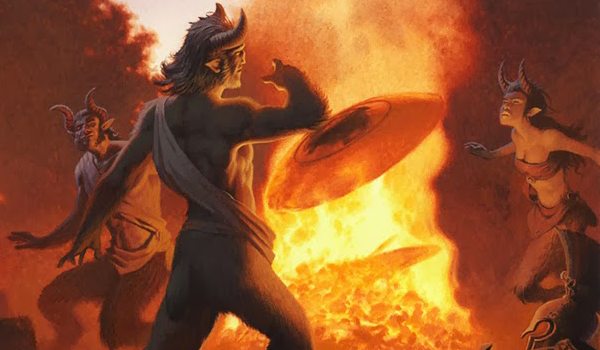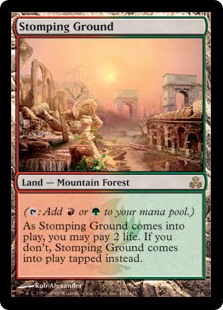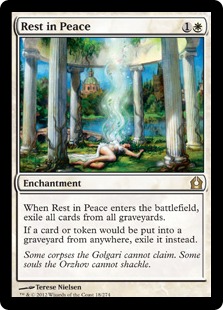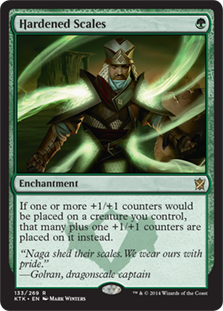Are you a Quiet Speculation member?
If not, now is a perfect time to join up! Our powerful tools, breaking-news analysis, and exclusive Discord channel will make sure you stay up to date and ahead of the curve.
The earth is round, the pope is catholic, and Destructive Revelry belongs in the sideboard of every Modern Burn deck. While the first and the second principle might be unbreakable, I’d like to smash the third one to smithereens. In this article I'll explain why I think Destructive Revelry is overrated in Burn, and lay out some of the flaws I see in the logic that says it's indispensable to the archetype.

What Type of Lavamancer Are You?
Revelry or not? Generations of red mages are still busy answering this standard question. Solving this destructive dilemma once and for all seems to be a mission impossible, but it isn't beyond the reach of reason.
The decision for or against playing Revelry is closely related to your general attitude and strategy as a Magic player. Basically there are two schools of thought.
Miscellaneousness, at any cost. Looking at the average Burn decklists, most players obviously still believe in an omnipotent sideboard that protects them against all threats—even if a destabilization of the mana base is the price of this intended progress. Having game against every deck is king! But is it really worth playing cards mainly because they change extremely unfavorable match-ups to slightly less unfavorable match-ups?
Consistency over perfection. The minority of Burn pilots prefer more consistency, and focus on improving slightly unfavorable or even match-ups to become favorable ones. They resign themselves to accept that burn cannot be well-prepared against every deck out there. Just take a look at the Burn lists of Legacy legend Patrick Sullivan. These all teach the same lesson: Keep it simple, keep it straightforward, and don’t get too gamey.
I definitely belong to the second group. Instead of worrying too much about bad match-ups, I put my efforts into improving the balanced ones. A few months ago—after having played Burn for several years—I finally decided to stick to a straight red-white Boros list, partially inspired by the great articles of Chained to the Rocks advocate Mike Flores. Since then I haven’t looked back to any of the Naya versions—even less so after a 2nd-place finish at a Modern PPTQ some weeks ago with the following list:
Boros Burn, by Andreas Breuer (2nd, PPTQ)
I really enjoyed the deck, although I unfortunately lost to Dredge in the finals. However, the tournament was one more confirmation of my belief regarding Burn: Don’t play cards that obstruct more than they help!
Here are five reasons why I believe that most of the time Destructive Revelry—and Stomping Ground, the necessary evil that accompanies it—isn't the real deal.
1. Stomping Ground Is the Worst Maindeck Card
Weakening my mana base only for a few sideboard cards? Thanks, but no thanks! Many say playing the card comes at no real cost. But it does! The single copy of Stomping Ground often forced me to question decent starting hands. Every time you draw it in the early stages of a pre-board game, it either shocks you needlessly, or slows you down significantly because you play it tapped.
More than once I have looked at an opening seven like this:
- Mountain
- Stomping Ground
- Goblin Guide
- Lightning Bolt
- Lightning Helix
- Lightning Helix
- Boros Charm
If the Stomping Ground was an Inspiring Vantage, a Sacred Foundry, or a fetchland, keeping this hand would be a no-brainer. You could still go for it with the Ground of course, hoping to draw a white mana source, a fetchland or spells that only require red mana—but don’t tell me this gamble is a perfect plan.
 Even more importantly, in pre-board games (as well as in many match-ups after sideboarding) Stomping Ground is just a basic Mountain that costs two life to be played untapped. In a format overrun by aggressive creature strategies, every single point is a matter of life and death: Humans, Bant Spirits, Hollow One, Death’s Shadow, and Vengevine all attack you pretty fast and hard. Why would I want to shock myself needlessly with Stomping Ground in match-ups in which I don’t care about green mana anyway?
Even more importantly, in pre-board games (as well as in many match-ups after sideboarding) Stomping Ground is just a basic Mountain that costs two life to be played untapped. In a format overrun by aggressive creature strategies, every single point is a matter of life and death: Humans, Bant Spirits, Hollow One, Death’s Shadow, and Vengevine all attack you pretty fast and hard. Why would I want to shock myself needlessly with Stomping Ground in match-ups in which I don’t care about green mana anyway?
Against Merfolk with Spreading Seas, I’d rather board in Grim Lavamancers and more Searing Blaze effects in order to progress my own plan. And the Burn mirror? The player rejoicing when you draw Stomping Ground in this match-up is definitely your opponent!
2. Revelry: Not a Stone-Cold Hoser
Magic is famous for cards that shut down whole decks. The omnipresent Rest in Peace dismembers any graveyard plans, Ensnaring Bridge is a pain in the butt for most creature strategies, and Stony Silence sends artifact decks into an early retirement.
Revelry, however, is no such hoser at all.
 One of the main reasons to play the Stomping Ground/Destructive Revelry setup is the Bogles matchup. The deck unsettled the Modern format a few months ago, so it seems reasonable to be prepared. Bogles won't be on top forever—but even more importantly, it is a bad match-up for Burn no matter what you do. While Revelry may save you against the hexproof strategy occasionally, it more than often doesn’t turn the tide. Your opponent simply needs to open with one or two Leylines and play a Daybreak Coronet as follow-up, and you already need multiple Revelrys unless you want to die a sudden death. If the Bogles man fails to live the dream, I hope my Eidolons, Skullcracks, and a well-placed Deflecting Palm are enough to steal the game; if not I’ll shake hands and move on.
One of the main reasons to play the Stomping Ground/Destructive Revelry setup is the Bogles matchup. The deck unsettled the Modern format a few months ago, so it seems reasonable to be prepared. Bogles won't be on top forever—but even more importantly, it is a bad match-up for Burn no matter what you do. While Revelry may save you against the hexproof strategy occasionally, it more than often doesn’t turn the tide. Your opponent simply needs to open with one or two Leylines and play a Daybreak Coronet as follow-up, and you already need multiple Revelrys unless you want to die a sudden death. If the Bogles man fails to live the dream, I hope my Eidolons, Skullcracks, and a well-placed Deflecting Palm are enough to steal the game; if not I’ll shake hands and move on.
One final note here: if you disagree with my logic and still want to play Revelry, make sure you do it properly. Without playing the full playset I don’t see the purpose of splashing green at all. I often see lists containing just 2 or 3 Revelrys in the sideboard. This just dilutes the whole plan.
I don’t really have to go through the same argumentation for the bad Ad Nauseam match-up as well, do I?
3. Revelry Is Only Mediocre Versus Artifact Strategies
How often did I curse Revelry as the master plan against Affinity. Managing your life total matters a lot in this match-up. If you don’t draw an Inspiring Vantage you would have to fetch-shock yourself twice to have access to green and white mana. I even looked at opening hands containing Revelry but neither Stomping Ground nor a fetchland—it’s really frustrating to ship decent hands because of this avoidable handicap.
In several matches my Affinity opponents even boarded in Blood Moon. While this would have been an exquisite plan against a Revelry player, it falls flat against a slew of extra Searing Blazes in the form of the powerful Smash to Smithereens.
 Against the Modern rookies, KCI and Hardened Scales, Revelry is just okay. Removing only one artifact often doesn’t cut the mustard to break up their synergies. Even worse, opponents playing these decks have so many possibilities to sacrifice targeted artifacts that they can easily play around the 2 points of damage.
Against the Modern rookies, KCI and Hardened Scales, Revelry is just okay. Removing only one artifact often doesn’t cut the mustard to break up their synergies. Even worse, opponents playing these decks have so many possibilities to sacrifice targeted artifacts that they can easily play around the 2 points of damage.
I never liked boarding Revelry versus Tron decks either, because they can easily remove Stomping Ground with Karn Liberated or Ghost Quarter. By contrast, an early Smash is just gas against Expedition Map or Chromatic Sphere, and even buys you time against a Wurmcoil Engine while still dealing 3 points of damage.
4. Minimize Missteps Without Revelry
Revelry often presents a decision point that can be hard to make correctly with limited information. You're left guessing at the optimal play, which will depend heavily on the opponent's deck and the cards drawn. Have you ever asked yourself what the right time is to fetch for Stomping Ground if you have no Revelry in hand? Do you fetch early, lose two points of life and take the risk of getting the land destroyed? Or do you fetch (too) late and have no access to green mana when needed?
The final match of GP Toronto 2018 between Dan Ward and Jon Stern is a vivid example of the disasters Stomping Ground can cause. Stern needs to fetch for another land in order to cast Skullcrack in response to Ward’s attack with a crowned Bogle. As Stern doesn‘t possess Revelry, he fetches for basic Mountain to save a few points of life. Ironically, the next card he draws is a copy of Revelry which he cannot cast now. You can see this beginning around 33:30 in the video.
[youtube https://www.youtube.com/watch?v=Sy4L0LXrD1g?t=33m30s]
Situations like this that foster unlucky results come up far more often than you would think—a risk that I want to avoid in future games. By cutting Revelry and Stomping Ground, I reduced the number of these guesswork scenarios that arise.
5. Revel in Your Revelry Alternatives
The great thing about Modern? You always have a choice. There’s no need to splash a color only for a couple of sideboard cards. The giant card pool offers options which can replace deadlocked strategies. If you care about artifacts, Smash to Smithereens, Shattering Spree, and Stony Silence all outclass Revelry by far. If you still don’t want to forgo a card that deals with enchantments, Wear // Tear might be your option. I don’t particularly like this card either (although it can be an effective 2-for-1 against Hardened Scales), and would rather try to dodge enchantments, but still prefer it over Revelry in Boros Burn. Side note: Against the unfavorable Bogles matchup, Ensnaring Bridge is another alternative, but we have to be careful of its non-bo with Deflecting Palm.
When to Play Destructive Revelry?
I don’t generally claim Destructive Revelry is a bad card. It still has its place in Modern because of its useful triple function: destroying artifacts, demolishing enchantments, and dealing damage.
There are two scenarios in which I prefer playing Revelry:
- You already play Naya Burn (including Wild Nacatl and Atarka's Command) or Nocatl Burn (without the cat), and thus have 4 to 8 cards in your main deck that require green mana.
- You know that your meta is full of decks that rely strongly on enchantments.
However, if you otherwise favor a red-white Boros list and don’t know which decks to expect at a tournament, I highly advice you drop Revelry.
Need any more proof that keeping your Burn board Boros leads to success? Flores-companion and Burn enthusiast Roman Fusco has played straight Boros Burn quite successfully for some time, and recently won a PPTQ with this list:





As someone who plays Modern Burn only slightly less often than I breathe, I couldn’t agree more with this. Revelry in the board with no other green spells is not where Burn wants to be.
My Experiences playing burn is that atarka’s command is the most powerful 2 drop to a burn player doing at 4-5 damage on average and holding incidental hosing versus lifegain cards is the instability not worth it??
I have to contest that Atarka’s Command does 4-5 damage on average. I would guess the average is closer to 3.5. I think maindeck Command is a meta call. The slower your meta, the better Command becomes.
…”Why to Keep[…]” isn’t in the English language’s playbook…it even sounds wrong.
Hi Alex,
thanks for your feedback. As headlines are often not complete sentences, it should be fine to have “why” followed by “to” (as part of an infinitive verb). Probably you are familiar with headlines beginning with “how-to”, or similar ones:
How to write an essay
What to do when you have a cold
Who to go to for help
“Why to” is a statement that implies you already know the answer and it is just as valid as “how to” etc.
I don’t particularly play burn but it was still a nice, in depth article to read.
Thanks for the article. Just a few things and please don’t take it personal.
I dislike the article a bit, because you’re only discussing why Revelry is bad. I haven’t been playing Burn for a long time, but enought to at least say that this doesn’t convince me in any way to switch to Boros. There are downsides and I don’t think they are as significant as the article makes you think. Additionally there is a big big upside in playing Revelry: You’re not stone cold dead to Leyline. If you go to a GP and you’re playing against Leyline 3 times you will hate yourself so so much. And at a GP that can be the case 100%. Of course you can take a meta into account, but for the most part that doesn’t matter too much, because you will play 10-13 different decks. I know you can kill the Leyline opponent with creatures, but that doesn’t come up very often.
Again I agree with the downsides, but it just doesn’t convince me. Stomping Ground is the worst maindeck card, but how often does it actually matter? Revelry is not a stone cold hoser, but the best way to fight Leyline. It’s not mediocre against Artifact strategies, it’s very good, but obviously not as good as Smash. It’s a very small sample size, but I won 7 out of 8 with Revelry against Affinity in the last month, did the 2 life matter or the 1 point of dmg? I don’t know, but it didn’t feel like it. If my Affinity opponent boards in Blood Moon I’m actually happy. Are you sometimes in an awkward position to fetch? Yes you are, but it’s rarely the case and you can anticipate it.
Last but not lesst, you will obviously find Boros lists which did great if you want to find some and underline your points. If I go to mtggoldfish of the last 3 burn decks (1x GP Top8, 2x SCG Open Top8) you got 2x with Revelry, 1x without.
What does that leave us with? It just doesn’t matter what you play right now. You can play Revelry or you just don’t. Either way you can win with burn. Revelry gives you some edges and takes away some and so does Boros.
As already said, thanks for the article, it’s a good discussion topic.
I think the issue is the real issue of why you run destructive revelry or not, isn’t discussed. It has to do with how many lavamancers in main, and searing bloods in sb you want. If you expect an aggro heavy meta you go with more searing blood in sb and more lavamancers. If you expect a combo or control meta you go naya and try to get under it with shard volley and command. It really has to do with what the meta is. As the format has gained more decks that flood the ground with dudes lavamancer became better, and so does searing blood. Also command becomes worse because it is just another shock you take, and you would rather have a helix. The choice of how heavy to go green or if to go it at all is meta call.
Hi,
I play A LOT of modern, but the article was tricky to understand because I haven’t played a lot of burn, and have played none in the last 12 months. 2 bits of (hopefully) constructive feedback.
1. Your first example hand with the stomping ground is awkward, but you then say “if the stomping ground was x,y or z”… But at no point in the article did you state what the stomping ground replaces. Its all well and good saying “if it was a fetch”, but what does stomping ground replace? Is it a basic mountain? If so, this hand would still have been a risk if the stomping ground was just a 2nd basic. In order to understand the example, I went to mtgtop8 to scour burn lists to work out what the Stomping Ground normally replaces (appears to be Inspiring Vantage, which backs up your argument). It shouldn’t be necessary for me to have to do research to understand the discussion here.
2. You also state quite early on something along hte lines of “do you try to fix your terrible match-ups with revelry or ignore them”. But, I have to wait a long time to know what those terrible match-ups are. Im reading the early statements and I’m trying to work out where I stand on Revelry (does it fix bad MUs or not), but I dont know what the MUs are. Therefore, I’m reading the statement but it doesn’t actually mean anything. You mention Bogles and Ad Nauseum as bad MUs, but no others. You mention other decks where you want “shatter”, but for all I know, those are favourable/even MUs already.
Whether you can fit this all into 1 article or not, I don’t know. But for me, it’d have been interesting to know which MUs are close AND want Revelry. Those scenario’s likely want Revelry to get those extra couple of points of damage across the line. At present, I know that Revelry affects your manabase, and doesn’t fix your 2 terrible MUs. I don’t know anything else.